The Home Depot
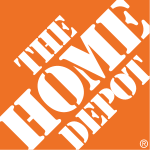 | |
|
The Home Depot corporate headquarters outside Atlanta. | |
| Public | |
| Traded as | |
| Industry | Retailing |
| Founded |
1978 Marietta, Georgia, U.S. |
| Founders |
Bernard Marcus Arthur Blank Ron Brill Pat Farrah Kenneth Langone |
| Headquarters | Atlanta Store Support Center, Cobb County, Georgia, U.S. |
Number of locations | 2,000+ |
Areas served |
United States Canada Mexico Puerto Rico |
Key people |
Craig Menear (Chairman & CEO) |
| Products | Home appliances, tools, hardware, builders hardware, lumber, building materials, paint, plumbing, flooring, garden supplies & plants |
| Revenue |
|
|
| |
|
| |
| Total assets |
|
| Total equity |
|
Number of employees | 400,000 (2017)[2] |
| Subsidiaries | Interline Brands |
| Website |
homedepot |
The Home Depot Inc. or Home Depot is an American home improvement supplies retailing company that sells tools, construction products, and services. The company is headquartered at the Atlanta Store Support Center in unincorporated Cobb County, Georgia (with an Atlanta mailing address).
It operates many big-box format stores across the United States (including all 50 states, the District of Columbia, Puerto Rico, the Virgin Islands, and Guam), all 10 provinces of Canada, and the 32 federal entities of Mexico. The MRO company Interline Brands is also owned by The Home Depot with 70 distribution centers across the United States.[3][4]
The Home Depot is the largest home improvement retailer in the United States, ahead of rival Lowe's.[5]
History
1978–1999

The Home Depot was co-founded by Bernard Marcus, Arthur Blank, Ron Brill, and Pat Farrah in 1978.[6] The Home Depot's proposition was to build home-improvement superstores, larger than any of their competitors' facilities. Investment banker Ken Langone helped Marcus and Blank to secure the necessary capital.
| “ | Bernie and I founded The Home Depot with a special vision – to create a company that would keep alive the values that were important to us. Values like respect among all people, excellent customer service and giving back to communities and society[7] | ” |
| — Arthur Blank | ||

In 1979, the first two stores, built in spaces leased from J. C. Penney that were originally Treasure Island "hypermarket" (discount department and grocery) stores, opened in metro Atlanta (in Doraville and on Memorial Drive in Decatur, both near I-285)[8] on June 21. On September 22, 1981 The Home Depot went public on the NASDAQ and raised $4.093 million. The Home Depot joined the New York Stock Exchange on April 19, 1984.[9]
The Home Depot began to branch out of Georgia to Florida in 1981 with stores opening in Hollywood and Ft. Lauderdale. By 1984 The Home Depot was operating 19 stores with sales of over $256 million. To enter the Dallas market The Home Depot acquired Bowater Home Center from Bowater Inc. on October 31, 1984 for $40 million.[10] The increased expansion of The Home Depot in the mid-1980s created financial difficulties with earnings falling at 42% and debt rising to $200 million. The financial difficulties of The Home Depot also caused the stock price to fall. To curb The Home Depot difficulties it opened only 10 stores in 1986 with a stock offering 2.99 million shares at $17 per share that helped The Home Depot to restructure its debts.[11]

In 1989 The Home Depot became the largest home improvement store in the United States surpassing Lowe's. In the 1990s The Home Depot searched for ways to redefine its marketplace. An installation program for quality home improvement items such as windows or carpets was launched in 1991 called the EXPO with success. A 480-page book Home Improvement 1-2-3 was published in 1995. The Canadian hardware chain Aikenhead's Hardware was acquired by The Home Depot in 1994 for $150 million with a 75% share. All of the Aikenhead's Hardware stores were later converted to The Home Depot stores.[12] By 1995, sales reached $10 billion while operating 350 stores.
Former General Electric executive Robert Nardelli became CEO and President of The Home Depot in 2000.[13]
2000–2007
San Diego maintenance and repair supplies company Maintenance Warehouse was purchased by The Home Depot in 1997 for $245 million.[14] Maintenance Warehouse was purchased because it was a leading direct-mail marketer of maintenance, repair and operations supplies that can reach customers out of reach by The Home Depot.[15][16] Atlanta-based company Apex Supply was acquired by The Home Depot in 1999. Apex Supply is a wholesale distributor of plumbing, HVAC, industrial pipe and fittings.[17] Apex Supply and Maintenance Warehouse were rebranded in 2004 as The Home Depot Supply.[18]
In 2004, Home Depot employees at a suburban Detroit store in Harper Woods, Michigan, rejected a bid to be represented by a labor union, voting 115 to 42 against joining the United Food and Commercial Workers. If the union had won, the Michigan store would have been the first Home Depot to have union representation.[19]
Your Other Warehouse, a large plumbing distributor with a focus on special order fulfillment, was acquired by The Home Depot in 2001. Your Other Warehouse also supplied two divisions of The Home Depot and the EXPO Design Centers.[20] The EXPO Design Center division was reorganized in 2001 with three divisions based in the Northeast at South Plainfield, New Jersey, the West at Orange, California, and the Southeast at Atlanta, Georgia.[21]
The Home Depot entered the Mexican market in 2002 with the acquisition of the home improvement chain Del Norte. In addition, The Home Depot had begun construction of stores in Mexicali and Tijuana.[22] In the same year the Home Depot Landscape Supply was launched to integrate professional landscapers and upscale plants into a plant nursery retail chain.[23] Home Depot Landscape Supply lasted only five years with only a few stores each in metro Atlanta and Dallas/Fort Worth. The Home Depot decided to close all Home Depot Landscape Supply stores in late 2007.[24]
In September 2005, Home Depot Direct launched its online home-furnishings store, 10 Crescent Lane, shortly followed by the launch of Paces Trading Company, its online lighting store. In mid 2006, the Home Depot acquired Home Decorators Collection, which was placed as an additional brand under its Home Depot Direct division.
In 2006, the Home Depot acquired Hughes Supply the largest home retailer in the United States for $3.2 billion.[25] Hughes Supply was integrated into The Home Depot Supply to better serve business-to-business customers.[26] The Home Depot Supply rebranded under the new name HD Supply in January 2007.[27] Five months later The Home Depot sold HD Supply to a consortium of three private equity firms, The Carlyle Group, Bain Capital and Clayton, Dubilier and Rice (with each agreeing to buy a one-third stake in the division).[28]
2007–present
On January 2, 2007, the Home Depot and Robert Nardelli mutually agreed on Nardelli's resignation as CEO after a six-year tenure. Nardelli resigned amid complaints over his heavy-handed management and whether his pay package of $123.7 million (excluding stock option grants) over the previous five years was excessive, considering the stock's poor performance versus its competitor Lowe's. His severance package of $210 million was criticized because when the stock went down, his pay went up.[29][30]
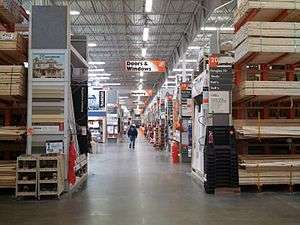
His successor, Frank Blake, previously served as the company's vice chairman of the board and executive vice president. Blake agreed to a much more conservative compensation package than Nardelli, that is very heavily dependent upon the success of the company. Although a longtime deputy to Nardelli at GE and Home Depot, Blake was said to lack Nardelli's hard edge and instead preferred to make decisions by consensus. Indeed, Blake repudiated many of his predecessor's strategies, and it has been reported that the two men have not spoken since Nardelli departed Home Depot.[29][31]
In 2008 and 2009, with the downturn in the housing market, The Home Depot announced the layoff of several thousand associates, as well as the closing of 54 stores nationwide, including the entire EXPO Design Center chain.[32] Associates at EXPO were allowed to re-apply for Home Depot jobs after the layoffs, and did not lose any tenure if hired back. In the year of February 2009, sales totaled $71.288 billion, more than $20 billion down from the peak of two years earlier due to the sale of HD Supply and falling revenue at the retained business. In 2012, they proceeded to close the big-box style stores that they had in China, however smaller stores that specialized in custom products and focused on more intimate interactions between customers and associates remain open there.[33][34]
In 2013, The Home Depot established two large distribution centers in Atlanta and Los Angeles.[35]
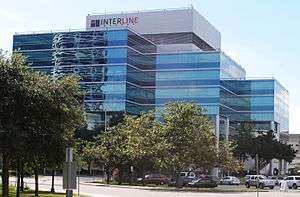
In August 2014, it was announced that Frank Blake would step down as CEO and would be replaced by 57-year-old Craig Menear. The change occurred on November 1, 2014. Blake would continue with the company as chairman. Menear joined The Home Depot in 1997, and served in various management and vice-presidential positions, until 2003, including merchandising vice president of hardware, merchandising vice president of the Southwest Division, and divisional merchandise manager of the Southwest Division. He subsequently served as senior vice president of merchandising from August 2003 to April 2007. He then served as an executive vice president of merchandising from April 2007 to February 2014. Until becoming CEO, Menear served as president of U.S. Retail from February 2014 to November 1, 2014.[36]
The company had a data breach in September 2014.[37] One major reason for the data breach was the practice of entering credit card numbers directly into computers at the service-desk and pro-desk, and in specialty departments including flooring, kitchen cabinets, appliances, and millwork, rather than using POS credit card terminals directly. The practice was stopped, and Home Depot offered a year of free credit monitoring through AllClearID for any customers who requested it. There were also reports of credit card numbers being stolen when used to make purchases on Homedepot.com.
On July 22, 2015, Home Depot acquired Interline Brands from P2 Capital Partners, Goldman Sachs' private equity arm, and the management of Interline Brands for $1.6 billion.[38] Interline Brands became fully integrated with The Home Depot in August 2016 with the Interline Brands website merging with The Home Depot website. The subsidiaries of Interline Brands are now companies of The Home Depot.[39]
Mascot
The Home Depot's mascot has been Homer D. Poe since 1981, when it was first used in advertising. Gwyn Raker, the illustrator says, "I designed him to be a funny guy next door who wasn't intimidating." The Homer Fund, a for-associate charity, is named after the mascot, who since its creation, has been a part of Home Depot culture ever since. This includes signage, advertising, awards and even a life-size costume for stores to rent out. Homer has a wife, named Daisy. [40]
Operation

Home Depot stores average 105,000 ft2 (9,755 m2) in size and are organized warehouse-style, stocking a large range of supplies. Home Depot's two largest stores are located in Vauxhall, New Jersey, which encompasses 217,000 ft2 of space, and in Anaheim Hills, California where it encompasses 204,000 ft2.[41] The company color is a bright orange (PMS 165, CMYK 60M100Y, HEX FF6600), on signs, equipment and employee aprons. It was announced in August 2014 that Craig Menear will take over for Frank Blake as CEO while Blake will remain the chairman of the board.[42]
Marketing
The slogan "More saving. More doing." was introduced by The Home Depot in the March 18, 2009 circular, replacing "You can do it. We can help." which had been used since 2003.[43] Other slogans used in the past 25 years include "The Home Depot, Low prices are just the beginning" in the early 1990s and "When you're at the Home Depot, You'll feel right at home" in the late 1990s and "The Home Depot: First In Home Improvement!" from 1999 to 2003.[44]
US Stores division
Long-time employee Marc Powers became the head of Home Depot's US stores division in 2014. He took the place of Marvin Ellison, who left to become the chief executive of J.C. Penney. In January, 2016 Home Depot announced the departure of Powers as division head, to be replaced by another veteran employee, Ann-Marie Campbell, one of Powers' deputies. The change in leadership is effective as of February 1, 2016. Ms. Campbell has been employed by Home Depot for over 30 years, beginning as a cashier in a branch in South Florida. Her most recent role was as president of Home Depot's Southern division.[45]
Distribution centers
The Home Depot has over 90 distribution centers throughout the United States to serve over 2,000 The Home Depot stores.[46]
Interline Brands
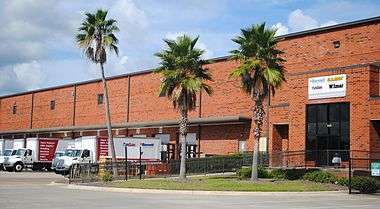
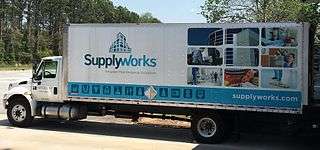
Interline Brands has over 90 distribution centers throughout the United States, Canada and Puerto Rico that serves customer needs for MRO supplies.[47]
The brands of Interline Brands includes:
- Wilmar Industries (MRO)
- Barnett (MRO, contractor supplies)
- SupplyWorks (janitorial, packaging, MRO)
- US Lock (keys, security devices)
- Hardware Express (hardware supplies)
- Maintenance USA (MRO)
- Leran Gas Products (propane accessories)
Online
The domain homedepot.com attracted at least 120 million visitors annually by 2008 according to a Compete.com survey.[48] In the US HomeDepot.com has 5 Call centers located in Kennesaw, GA; Atlanta, GA; Marietta, GA; Ogden, Utah and Tempe, AZ. Home Depot online offers in-store pickup and online returns.[49]
The website is inaccessible through servers outside of the countries the brand is serving.
Exclusive brands
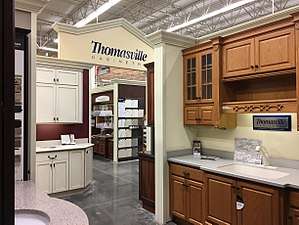
The Home Depot exclusively carries several major brands, including:
- Chem-Dry (carpet cleaning, upholstery cleaning, tile and grout services)
- Behr paints
- Homelite (outdoor and power tools)
- Martha Stewart Living Omnimedia (outdoor furniture, indoor organization)
- Ryobi and Ridgid (power tools)
- American Woodmark cabinetry
- Thomasville Furniture Industries cabinetry
Additionally, the retailer has its own house brands:
- Husky (tools)
- Workforce (tools, shelving, storage cabinets, extension cords, worklights, tarps, paintbrushes)
- HDX
- Glacier Bay (kitchen sinks, faucets, etc.)
- Commercial Electric
- Home Decorators Collection
Fuel centers
In 2006, The Home Depot started testing fuel centers at some of its stores. The first such "Home Depot Fuel" convenience store (C-Store) was located in Brentwood, Tennessee followed a month later by a center about 20 miles (32 km) away in Hermitage, both suburbs of Nashville. Four additional prototype stores were built within the year at Acworth, Georgia; Smyrna, Tennessee; Greensboro, Georgia; and then Winchester, Tennessee in that order. The centers were expected to earn $5–$7 million per year, though the actual number was reported to be much higher. The fuel centers sell beer, hot food, and snacks along with providing diesel fuel and gas at a separate island. This allows contractors with large trucks to be able to fill their vehicles. The fuel centers offer car washes, which are large enough to accommodate full-size pickup trucks and other large commercial vehicles.[50]
Corporate affairs
Board of directors
Current members of the board of directors of the Home Depot are: F. Duane Ackerman, David H. Batchelder, Frank Blake, Ari Bousbib, Gregory D. Brenneman, Albert P. Carey, Armando Codina, Bonnie G. Hill, and Karen Katen.[51] The Home Depot's board consists of 9 members, with 8 of them being independent directors.
Philanthropy
The Home Depot Foundation is the philanthropic arm of the company created in 2002. It has contributed over $200 million in time, labor, money, and supplies to a number of causes, including Habitat for Humanity, California-based City of Hope National Medical Center, and playground construction organization KaBOOM![52] Home Depot supports the U.S. Military community with a 10% military discount.
The Home Depot has partnered with the Georgia Emergency Management Agency's Ready Georgia campaign, leading both supplies and facility use to this statewide effort to increase emergency preparedness among Georgia's children.[53] The company also provided ready kits and other prizes for an art and essay contest for Georgia elementary school students.[54]
In 2005, The Home Depot was among 53 entities that contributed the maximum of $250,000 to the second inauguration of President George W. Bush.[55][56][57]
In March 2018, the company donated $50 million to train 20,000 people as construction workers over the next decade. The Home Builders Institute will use the money to train veterans and U.S. Army soldiers, high school students and disadvantage youth. The financial support from Home Depot was to help address the needs of the shortage of construction workers.[58][59]
Environmental record
The Home Depot has stated on their website that they have a commitment "we continue to lead by example, demonstrating to the world that sustainability business practices are not only possible, they are good for business".[60] The Home Depot introduced a label on nearly 3,000 products in 2007. The label promotes energy conservation, sustainable forestry and clean water. Home Depot executives said that as the world's-largest buyer of construction material, their company had the power to persuade thousands of suppliers, homebuilders and consumers to follow its lead on environment sustainability. "Who in the world has a chance to have a bigger impact on this sector than Home Depot?" asked Ron Jarvis, vice president for environmental innovation at Home Depot.[61] This program is following The Home Depot's promise in the late 1990s to eliminate the number of sales of lumber from endangered forests in countries including Chile and Indonesia.[62] Home Depot has since worked with environmental groups to create a variety of green programs. For example, Home Depot planted thousands of trees at its headquarters in Atlanta to offset carbon emissions. In 2007, The Home Depot Foundation (the company's charitable foundation) committed to investing $100 million over the next decade to build over 100,000 green affordable homes and plant 3,000,000 trees.
Additionally, The Home Depot promotes compact fluorescent light bulbs in its stores. As part of this effort, the company created the largest recycling program in the United States for the bulbs.[63] In March 2013, Home Depot locations in Canada stopped accepting compact fluorescent light bulbs for recycling.[64]
Major sponsorships

Television
In 2002, The Home Depot joined PBS as a sponsor of This Old House and Ask This Old House.
In 2003, The Home Depot became a sponsor for Trading Spaces.
Sports
Company co-founder Arthur Blank purchased the Atlanta Falcons franchise of the National Football League in February 2002; Blank later acquired an expansion franchise in Major League Soccer, Atlanta United FC, in April 2014 with the soccer club beginning play in March 2017. The Home Depot made no formal association with the Falcons until April 2017, when The Home Depot acquired the naming rights to the 11-acre (44,520 m2) park adjacent to Mercedes-Benz Stadium. The Home Depot Backyard occupies the site of the Falcons' previous stadium, the Georgia Dome, and serves as parking and tailgating space during Falcons' and Atlanta United FC home games and public use greenspace during non-event days. The park opened on September 11, 2018.[65][66]
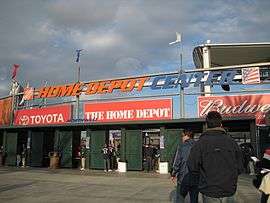
Since 1991, the company has become a large supporter of athletics, sponsoring the United States and Canadian Olympic teams, and launching a program which offered employment to athletes that accommodates their training and competition schedules. The Home Depot ceased to be a sponsor of the Canadian Olympic Team in 2005 and ended a sponsorship program for the United States Olympic team in 2009.[67]
The Home Depot has been a major sponsor for Joe Gibbs Racing in NASCAR since 1999. Their arrival into the series coincided with Tony Stewart leaving the Indy Racing League to join what is now the Sprint Cup Series. Stewart drove The Home Depot-sponsored #20 car for Joe Gibbs Racing until 2008, winning 2 of his 3 series championships in the car, and was succeeded by Joey Logano, who took the car to victory lane twice. After Matt Kenseth joined the team, The Home Depot's status as the #20's primary sponsor was taken over by Dollar General, but the company still served as its most frequent secondary sponsor through its Husky Tools division. On June 23, 2014, the company announced it would end its NASCAR sponsorship after 2014.[68]
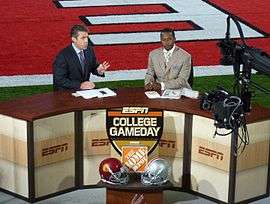
The Home Depot was the title sponsor of The Home Depot Center in Carson, California, home to the Los Angeles Galaxy of Major League Soccer; the venue was formerly the home of Chivas USA of MLS, which folded in 2014, and the Los Angeles Riptide of Major League Lacrosse, which folded in 2008. The venue is now called StubHub Center.
In 2006, The Home Depot partnered with Duke University's Edmund T. Pratt Jr. School of Engineering to create "The Home Depot Smart Home". The smart home is a live-in laboratory for ten upper-class engineering students that allows them to immerse themselves in the work. The goal of the project is to help provide innovative solutions for the home in areas such as security and home monitoring, communications, energy efficiency, entertainment, environment and health.[69]
In January 2007, The Home Depot became the official home improvement sponsor of ESPN's College Gameday.[70]
Politics
Seventy-three percent of The Home Depot's campaign contributions went to Republican candidates in the 2005–2006 US elections. "Home Depot's PAC gives money based on a candidate's voting record, committee assignment and leadership position," said company spokesman Jerry Shields.[71] The CEO in this period was Bob Nardelli, a friend of U.S. President George W. Bush.[72] Nardelli hosted a garden reception/fundraiser for Bush at his Atlanta home on May 20, 2004.[73]
Outside the US

Canada
Home Depot Canada is the Canadian unit of the Home Depot and one of Canada's top home improvement retailers. The Canadian operation consists of 182 stores and employs over 28,000 people in Canada. Home Depot Canada has stores in all ten Canadian provinces and serves territorial Nunavut, Northwest Territories, and Yukon through electronic means (Online Sales). The Canadian head office is located in Toronto.
The Canadian unit was created with the purchase of Aikenhead's Hardware. Home Depot management had an ambitious plan to overtake its biggest competitor, RONA, which has about four times as many stores. However, some of RONA's stores are smaller than the typical Home Depot store. In terms of big box stores, the Home Depot has more stores than RONA (not including other Rona banners such as Réno Dépôt or Cashway). As of 2007, RONA pulled ahead of The Home Depot in total retail sales, due to aggressive consolidation efforts by RONA, combined with the loss of The Home Depot's industrial supply division, HD Supply, in July 2007. The Home Depot now faces competition from Lowe's as they have moved into the Canadian market effective the end of 2007; Lowe's now has 35 outlets in Canada. In 2016 RONA was purchased by Lowes increasing its total store count to over 500 units.
In Quebec, where it has 22 stores, The Home Depot is branded simply "Home Depot" (using English words but without the definite article "the").
Mexico
The Home Depot operates 106 stores in Mexico[74] and has become one of the largest retailers in Mexico since it entered the market in 2001. The Home Depot increased its presence in Mexico in 2004, with the acquisition of Home Mart, the second largest Mexican home improvement retailer.
The Home Depot Mexico employs more than 11,000 associates throughout the country and has an annual growth rate of 10 percent.[75]
China
In December 2006, the Home Depot announced its acquisition of the Chinese home improvement retailer The Home Way.[76] The acquisition gave the Home Depot an immediate presence in China, with 12 stores in six cities.
In April 2011, Home Depot shut its last Beijing store, the fifth Home Depot to close in China in the previous two years. In September 2012, The Home Depot announced it was closing all big box stores in China. The Home Depot retained two specialty stores in China, a Home Decorators Collection Store and a paint and flooring store.[77]
As of September 16, 2012, all seven of the box stores in China had been shut down.[78] The Home Depot has no immediate plans to further expand its specialty stores in China. The company is taking a "wait-and-see" attitude towards the Chinese market, but does not want to completely pull out because re-entry into the market would be very costly.
The Home Depot's lack of success in China has been attributed to the disconnect between The Home Depot's do-it-yourself ethos and Chinese culture. In 2012, the Home Depot conceded that it misread the country's appetite for do-it-yourself products. As a spokeswoman for the company said in an interview with the Wall Street Journal, "The market trend says this is more of a do-it-for-me culture".[77] Culturally, manual labor is seen as an activity for lower-class citizens, and some have speculated that The Home Depot could have capitalized on this by offering a do-it-for-me model to Chinese consumers. Chinese consumers prefer to see a finished product, such as a renovated room, rather than light bulbs and lumber.[79] The same issue does not exist outside of China, especially in Canada, where Chinese Home Depot advertisements and store signage can be found in areas with large Chinese demographics.
United Kingdom
There were reports that The Home Depot was interested in acquiring B&Q, the largest DIY retailer in the United Kingdom, Ireland and China. Speculation of a takeover began in 1999 when the retailer Asda was purchased by Walmart. The Home Depot would have to acquire Kingfisher plc, B&Q's parent company, to acquire B&Q. Kingfisher consists of several European DIY chains; however, the Home Depot was only interested in B&Q operations and says that it would dispose of the Castorama chain which operates in France, Italy, Poland and Russia. Talks ending in 2005 did not result in any takeover deal.[80][81][82][83]
South America
In 1997, Home Depot entered the Chilean and Argentine markets. While the venture was viewed with great optimism by founders Bernard Marcus and Arthur Blank,[84] it eventually proved unprofitable. In October 2001, Chilean partners Falabella bought out Home Depot's share of the five Chilean Home Center stores and rebranded them Home Store. In 2003, after merging with Sodimac, all stores adopted that brand. The company has since expanded across Latin America very profitably and successfully. It's currently the N°1 Home Improvement company in South America. In 2002, Argentina's Home Depots were bought out by Chilean company Cencosud and rebranded Easy stores, a company that has also expanded across South America. It's currently the N°2 Home Improvement company in South America.
Controversy
Whistleblower case
The Home Depot was embroiled in whistleblower litigation brought under the Sarbanes-Oxley Act (SOX) law. In July 2005, former employee Michael Davis, represented by attorney Mark D. Schwartz filed a whistleblower lawsuit against the Home Depot, alleging that his discharge was in retaliation for refusing to make unwarranted backcharges against vendors. Davis alleges that the Home Depot forced its employees to meet a set quota of backcharges to cover damaged or defective merchandise, forcing employees to make chargebacks to vendors for merchandise that was undamaged and not defective. The Home Depot alleges that it fired Davis for repeatedly failing to show up for work.
The trial initially was concluded in June 2006, but in April 2007, U.S. Department of Labor Judge Pamela Lakes Wood ordered the case reopened after the Home Depot's law firm Akin Gump Strauss Hauer & Feld revealed that the retail giant's in-house counsel had told them that two Home Depot employees who testified at the trial had lied. Akin Gump sent Wood a letter on September 29, 2006, in which the law firm requested that the testimony be stricken. In response to Akin Gump's revelation, Davis' attorney Mark D. Schwartz asked for the case to be reopened to permit further questioning of the witnesses. On April 6, 2007, Wood ordered the case to be reopened.
Schwartz was quoted by the New York Post as saying, "I have reason to believe these witnesses were intimidated into giving false testimony." The Home Depot called Schwartz's allegations "meritless".[85]
Home Depot has settled the dispute in a stipulation of settlement dated March 28, 2008. In the settlement, Home Depot changed some of its corporate governance provisions. Home Depot also agreed to pay the plaintiff's counsel $6 million in cash and $8.5 million in common stock.[86]
Patent law controversy
Powell v. Home Depot USA, Inc. (2008cv61862) (2011) was a decision by the United States District Court for the Southern District of Florida concerning patent infringement on a "safe hands" device that Michael Powell, an independent contractor for Home Depot, created in response to injuries to the hands of associates using in-store radial arm saws. The District court jury returned a verdict in favor of Powell.
In 2011, Home Depot appealed against the decision to the United States Court of Appeals for the Federal Circuit, challenging the district court's denial of its renewed motion for judgment as a matter of law on the issues of infringement, willfulness, and damages.[87][88] They also challenged the district court's claim construction, inequitable conduct, and attorney fees determinations. The appellate court found no inequitable conduct and insufficiently egregious misconduct on the part of Powell's attorney.[89]
Tilt-up construction design of stores
In the wake of the 2011 Joplin tornado in which the walls of a Home Depot collapsed after being hit by an EF5 tornado, The Kansas City Star, citing engineers, criticized Home Depot's practice of using tilt-up construction in hundreds of its big-box stores (other nearby big-box stores in Joplin, including a Walmart and Academy Sports, which had concrete block construction, lost their roofs but the walls remained intact). In tilt-up construction the concrete is poured onsite, lifted into place, and then attached to the roof. The engineers told the Star that the practice, while normally safe and efficient, is dangerous in major storms because once the roof is lifted (as happened in Joplin) the walls collapse in a domino effect. Seven people were killed in the front of the store when the 100,000-pound walls collapsed on them, while 28 people in the back of the store survived when those walls collapsed outward. Only two of the slab walls in the Home Depot survived. In contrast, 3 people died in the Walmart but 200 survived. Engineers noted that when concrete block construction fails, structural elements break in pieces and usually not in huge slabs. Home Depot said it fundamentally disagreed with the engineers quoted by the Star and said it would use tilt-up construction when it rebuilds the Joplin store.[90]
Home Depot payment system breach
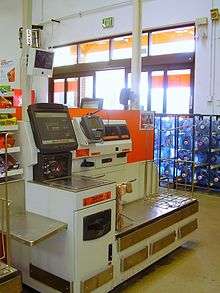
On September 2, 2014, security news reporter Brian Krebs reported that he was seeing evidence of credit card numbers linked to Home Depot purchases being sold online, which he concluded to suggest that The Home Depot's payment systems were breached by hackers.[91] On September 8, 2014, Home Depot confirmed that their payment systems were compromised. According to their press release, this breach affected any customers who made purchases at any Home Depot store from April 2014 to September 2014. Home Depot offered their affected customers free one-year credit monitoring service from AllClear ID. Also in their press release, they made sure to emphasize that there was no evidence to suggest that online customers were affected by the breach. On September 18, 2014, Home Depot released a statement saying that the hackers obtained a total of 56 million credit card numbers as a result of the breach. Since the breach, Home Depot has rolled out new encryption technology for their cash registers and self-checkout systems to protect customers. A class action lawsuit was filed against the company.
In March 2016 Home Depot agreed to pay at least $19.5 million to compensate the more than 50 million consumers affected. The settlement terms included a $13 million fund to reimburse shoppers and a $6.5 million fund for cardholder identity protection services.[92]
EEOC disability discrimination suit
In September 2012, Home Depot agreed to pay $100,000 and furnish other relief to settle a disability discrimination lawsuit[93] filed by the U.S Equal Employment Opportunity Commission, for the alleged failure to provide a reasonable accommodation for a cashier with cancer at its Towson, Maryland, store and then for purportedly firing her because of her condition.[94]
See also
- Lowe's, another American home improvement and construction product services, which competes with The Home Depot in the United States, Canada and Mexico.
- Home improvement
References
- 1 2 3 4 5 (XBRL). Home Depot. March 1, 2018 http://ir.homedepot.com/~/media/Files/H/HomeDepot-IR/reports-and-presentations/quarterly-earnings/q4-2017-press-release.pdf. Missing or empty
|title=(help) - ↑ (PDF). Home Depot. Mar 1, 2018 http://ir.homedepot.com/~/media/Files/H/HomeDepot-IR/reports-and-presentations/quarterly-earnings/q4-2017-press-release.pdf. Missing or empty
|title=(help) - ↑ "The Home Depot Completes Acquisition of Interline Brands, Inc". PR Newswire. August 24, 2015. Retrieved 9 April 2017.
- ↑ "Vinings CDP, Georgia". U.S. Census Bureau. Archived from the original on February 12, 2011. Retrieved July 4, 2011.
- ↑ Ausick, Paul (March 9, 2017). "Why Home Depot Dominates the Home Improvement Market". 247 Wall Street. Retrieved 9 April 2017.
- ↑ "Home Depot Corporate website: Our History". Home Depot Corporate website: Our History. Archived from the original on June 26, 2009. Retrieved June 11, 2009.
- ↑ Roush, Chris. Inside Home Depot. McGraw Hill.
- ↑ "Home Depot History". ext.homedepot.com. Archived from the original on September 4, 2014. Retrieved September 3, 2014.
- ↑ "Investor FAQ". The Home Depot, Inc. Archived from the original on January 23, 2016. Retrieved April 11, 2015.
- ↑ "Home Depot". New York Times. October 31, 1984.
- ↑ "The Home Depot, Inc. - Company Profile, Information, Business Description, History, Background Information on The Home Depot, Inc". Retrieved 21 April 2017.
- ↑ Strom, Stephanie (February 9, 1994). "COMPANY NEWS; Home Depot Buys Chain In Canada". New York Times. Retrieved 21 April 2017.
- ↑ "Home Depot Names GE's Nardelli As New CEO in a Surprise Move". Retrieved 22 April 2017.
- ↑ News, Bloomberg (1997). "HOME DEPOT TO PAY $245.4 MILLION FOR DIRECT MARKETER". The New York Times. ISSN 0362-4331. Retrieved 2017-11-28.
- ↑ "Home Depot Plans To Buy Maintenance Warehouse". New York Times. January 17, 1997. Retrieved 22 April 2017.
- ↑ "Home Depot Tightens Focus on Commercial Customers". Plumbing & Mechanical. Plumbing & Mechanical. 1997. Retrieved 22 April 2017.
- ↑ "Home Depot to acquire Apex Supply Co". Atlanta Business Chronicle. December 13, 1999. Retrieved 22 April 2017.
- ↑ "New Name For Apex Supply Co. And Maintenance Warehouse". Supply House Times. March 1, 2004. Retrieved 22 April 2017.
- ↑ "Home Depot Workers Reject Bid to Unionize". Floordaily.net.
- ↑ "Home Depot to acquire Your "other" Warehouse". Atlanta Business Chronicle. October 3, 2001. Retrieved 22 April 2017.
- ↑ "Home Depot To Redesign EXPO Division". VMSD. September 11, 2000. Retrieved 22 April 2017.
- ↑ "Home Depot acquires Del Norte". Atlanta Business Chronicle. March 21, 2002. Retrieved 22 April 2017.
- ↑ "Home Depot Landscape Supply Blooms in Atlanta". PR Newswire. August 1, 2002. Retrieved 22 April 2017.
- ↑ "Home Depot Closing Landscape Supply Stores". Chain Store Age. Retrieved 22 April 2017.
- ↑ Funk, Dale (January 1, 2006). "Home Depot to buy Hughes Supply for about $3.2 billion". Electrical Wholesaling. Retrieved 22 April 2017.
- ↑ "The Home Depot Completes Acquisition of Hughes Supply". Contracting Business. April 1, 2006. Retrieved 22 April 2017.
- ↑ "Wholesale Division of Home Depot Branded Under Name of HD Supply". Achrnews. January 29, 2007. Retrieved 22 April 2017.
- ↑ Alden, William (April 12, 2013). "HD Supply, Backed by Carlyle and Bain, Files for I.P.O." DealBook. Retrieved August 5, 2016.
- 1 2 "Robert Nardelli Resigns as Chairman and Chief Executive Officer of The Home Depot and Is Succeeded by Frank Blake". News Releases. The Home Depot. January 3, 2007. Archived from the original on January 23, 2016. Retrieved January 19, 2012.
- ↑ "Home Depot's Surprising Choice for CEO". BusinessWeek. January 4, 2007.
- ↑ Gogoi, Pallavi (January 4, 2007). "Home Depot's Surprising Choice for CEO". BusinessWeek. Retrieved April 29, 2012.
- ↑ Meg Marco (2009-01-26). "Bid Adieu To Home Depot's Expo Stores – Consumerist". Consumerist.com. Retrieved 2013-06-26.
- ↑ Jopson, Barney (September 14, 2012). "Home Depot shuts big box stores in China". Financial Times.
- ↑ Bhasin, Kim (September 14, 2012). "Home Depot Gives Up And Closes The Last Of Its Big Box Stores In China". Business Insider.
- ↑ "Home Depot to build two distribution centers to expand online fulfillment network". DC Velocity. March 22, 2013. Retrieved 22 April 2017.
- ↑ "Executive Profile Craig A. Menear". Bloomberg Business. Retrieved May 19, 2015.
- ↑ "Connecticut, Illinois, California lead probe into Home Depot data breach". Retrieved September 21, 2014.
- ↑ Bray, Chad (July 22, 2015). "Home Depot to Buy Interline Brands for $1.6 Billion in Cash". New York Times. Retrieved July 22, 2015.
- ↑ "How Interline, Home Depot are becoming 'one'". Jacksonville Business Journal. July 18, 2016. Retrieved 26 April 2017.
- ↑ "Meet Homer: The Home Depot's Much-Loved DIY Mascot". The Home Depot. 2015-01-23. Retrieved 2017-12-10.
- ↑ "The Home Depot opens its first Superstore in the West". The Orange County Register. Retrieved September 21, 2014.
- ↑ Sharf, Samantha. "Home Depot Announces New CEO, Frank Blake To Stay On As Chairman". Forbes. Retrieved 22 August 2014.
- ↑ "Home Depot Gets a Slogan Makeover". www.corporate-eye.com. Retrieved 2017-04-26.
- ↑ "Home Depot Slogan | Pro Tool Reviews". Pro Tool Reviews. 2009-03-24. Retrieved 2017-12-27.
- ↑ Ziobro, Paul (19 January 2016). "Home Depot Replaces Head of U.S. Stores Business". Wall Street Journal. Retrieved 21 January 2016.
- ↑ "Operations". The Home Depot. Retrieved 22 April 2017.
- ↑ "Home Depot to acquire Interline Brands". Industrial Supply. July 22, 2015. Retrieved 13 October 2016.
- ↑ "homedepot.com UVs for March 2012". Compete. Retrieved April 29, 2012.
- ↑ "We shopped at Home Depot and Lowe's to see which store was better — and the winner was clear for one key reason". Business Insider. Retrieved 2018-04-14.
- ↑ "The Home Depot Opens First Home Depot Fuel Location in Georgia". PR Newswire. September 25, 2006. Archived from the original on November 1, 2006.
- ↑ "Board of Directors". Corporate Governance. The Home Depot. May 21, 2008. Retrieved June 9, 2008.
- ↑ Bailey, M. "Business & Industry: The Home Depot". Georgia College and State University.
- ↑ "The Home Depot Partners with GEMA's Ready Georgia to Teach Thousands of Kids about Emergency Preparedness". Maintainx Cleaning Services. August 28, 2018.
- ↑ Congratulations to Our 'Get Ready Georgia' Art and Essay Contest Winners!, Ready Georgia
|access-date=requires|url=(help) - ↑ Drinkard, Jim (January 17, 2005). "Donors Get Good Seats, Great Access This Week". USA Today. Retrieved August 22, 2012.
- ↑ Staff (January 16, 2005). "Financing the Inauguration". USA Today. Retrieved August 22, 2012.
- ↑ Staff (January 14, 2005). "Some Question Inaugural's Multi-Million Price Tag". Associated Press (via USA Today). Retrieved August 22, 2012.
- ↑ "Exclusive: Home Depot to donate $50M to train construction workers, address severe shortage". USA TODAY. Retrieved 2018-04-30.
- ↑ "Home Depot takes a shot at tackling the construction labor shortage". Retrieved 2018-04-30.
- ↑ "Is Home Depot giving up on "Going Green" Strategies?". TreeHugger. Retrieved 2017-04-07.
- ↑ Barbaro, Michael (April 17, 2007). "Home Depot to Display an Environmental Label". The New York Times. Retrieved May 25, 2010.
- ↑ "Home Depot adopts new wood purchasing policy". Planet ARK. January 6, 2003.
- ↑ Rosenbloom, Stephanie (June 24, 2008). "Home Depot Offers Recycling for Compact Fluorescent Bulbs". The New York Times. Retrieved May 25, 2010.
- ↑ "Home Depot quietly ends light-bulb-recycling program". Cbc.ca.
- ↑ Stafford, Leon (21 April 2017). "Georgia Dome site to become park after demolition". The Atlanta Journal-Constitution. Retrieved 26 April 2017.
- ↑ "Home Depot Backyard opens at Mercedes-Benz Stadium". WAGA-TV. Retrieved September 12, 2018.
- ↑ "Home Depot ends Olympics sponsorship program". Reuters. 2009-01-08. Retrieved 2018-03-02.
- ↑ Pennell, Jay (June 23, 2014). "Report: Home Depot ending NASCAR sponsorship after 2014". Foxsports.com. Retrieved June 23, 2014.
- ↑ "Duke Announces Construction of 'The Home Depot Smart Home'". Duke University. October 24, 2006.
- ↑ "The Home Depot Becomes an Official NFL Sponsor". The Home Depot. January 9, 2007. Archived from the original on January 21, 2007.
- ↑ "Republican Candidates Increase Share of Business PAC Donations". Bloomberg. August 8, 2006.
- ↑ Weber, Harry R. (January 3, 2007). "Nardelli resigns abruptly as CEO of Home Depot, leaves with $210M". AP.com.
- ↑ Harris, Paul (May 23, 2004). "Bush's Super Fundraisers Join the Queue for Favours". The Guardian. Retrieved October 24, 2007.
- ↑ "Acerca de" (in Spanish). The Home Depot. Retrieved April 29, 2012.
- ↑ "The Home Depot – Home". Corporate.homedepot.com. June 22, 1979. Archived from the original on February 6, 2006. Retrieved April 29, 2012.
- ↑ "The Home Depot acquires The Home Way". Prnewswire.com. December 13, 2006.
- 1 2 Burkitt, Laurie (14 September 2012). "Home Depot Learns Chinese Prefer 'Do-It-for-Me'". The Wall Street Journal. Retrieved 19 February 2014.
- ↑ Staff (September 16, 2012). "Home Depot closes China stores, denies 'moving out'". China Times. Archived from the original on October 29, 2013. Retrieved January 1, 2013.
- ↑ Tulshyan, Ruchika. "Home Depot's failure in China: Ignoring women". Atlanta Business Chronicle. Atlanta Business Chronicle. Retrieved 19 February 2014.
- ↑ "Bid Talk Lifts Kingfisher Shares". BBC News. January 5, 2004. Retrieved May 25, 2010.
- ↑ Teena Lyons (May 8, 2005). "US giant targets B&Q DIY chain". This is Money. Retrieved April 29, 2012.
- ↑ Published on Monday May 9, 2005 01:29 (May 9, 2005). "The Scotsman". The Scotsman. Archived from the original on November 17, 2005. Retrieved April 29, 2012.
- ↑ "Kingfisher profit down 33% as B&Q unit takes a hammering". Abcmoney.co.uk. Retrieved 2013-06-26.
- ↑ Marcus, Bernie; Blank, Arthur; Andelman, Bob (1999). Built from Scratch. New York: Random House. pp. 300–302. ISBN 0-8129-3058-4.
- ↑ Kapner, Suzanne (April 12, 2007). "Home Depot Case Revived". New York Post. Archived from the original on October 15, 2007.
- ↑ "Home Depot Settlement". U.S. Securities and Exchange Commission. March 28, 2008.
- ↑ Michael S. Powell. "United States Court of Appeals for the Federal Circuit" (PDF). Patent4Life.
- ↑ "Powell v. Home Depot – False Petition Not "Egregious Misconduct"". The National Law Review. Schwegman, Lundberg & Woessner, P.A. November 16, 2011. Retrieved September 13, 2012.
- ↑ "Post-Therasense: Inequitable Conduct Really Is a Higher Standard". McDermott Will & Emery. 2011-12-05. Retrieved 2012-09-03.
- ↑ McGraw, Mike (June 25, 2011). "Experts Challenge Home Depot Building Design, Codes After Joplin Tornado". The Kansas City Star. Retrieved June 28, 2011.
- ↑ "Banks: Credit Card Breach at Home Depot". Krebs on Security. September 2, 2014.
- ↑ "Home Depot settles consumer lawsuit over big 2014 data breach". Reuters. March 8, 2016.
- ↑ "Complaint, U.S. Equal Employment Opportunity Commission v. Home Depot USA Inc" (PDF). PacerMonitor. PacerMonitor. Retrieved 16 June 2016.
- ↑ "Home Depot to Pay $100,000 to Settle EEOC Disability Discrimination Suit". The National Law Review. U.S Equal Employment Opportunity Commission. 2012-09-10. Retrieved September 23, 2012.
External links
| Wikimedia Commons has media related to Home Depot. |
- Home Depot, Inc. (Corporate website)
- Home Depot USA (English website)
- How I Built This Podcast - Live Episode! The Home Depot: Arthur Blank - Audio interview with co-founder
- Business data for The Home Depot: Google Finance
- Yahoo! Finance
- Reuters
- SEC filings